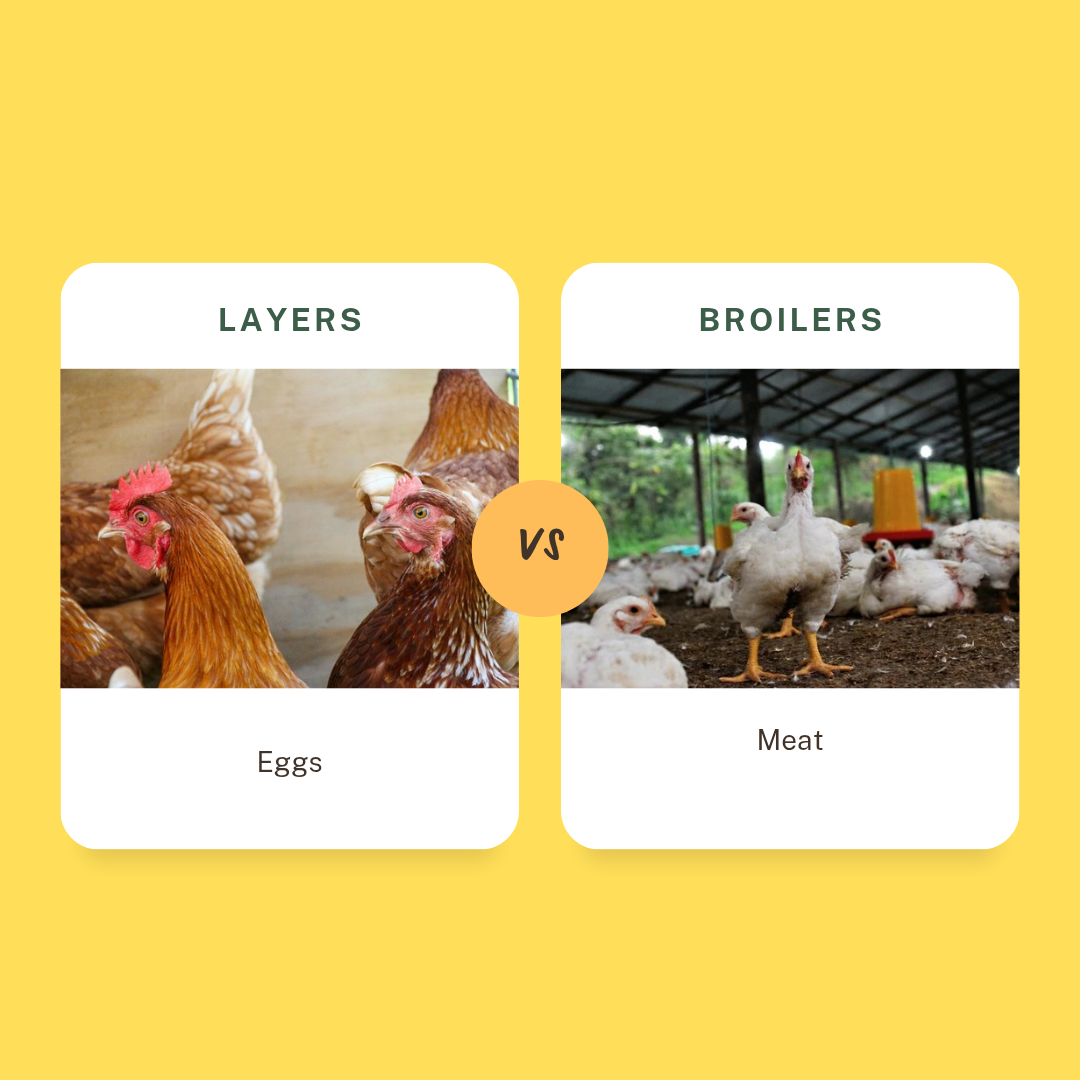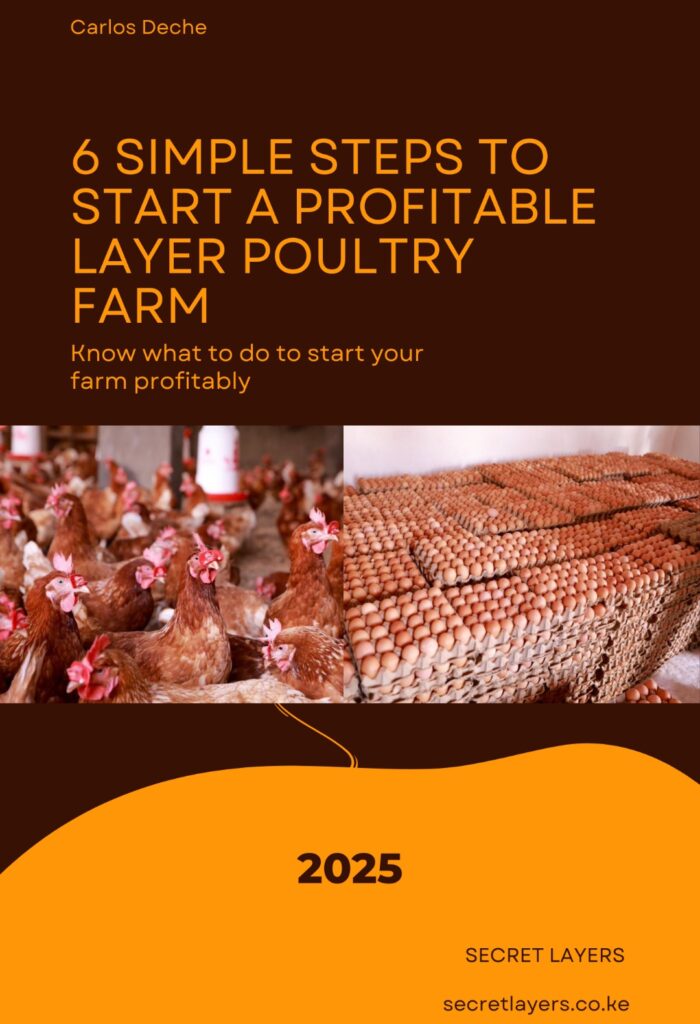You’ve decided to go into poultry farming, but now you’re stuck between layers and broilers, unsure of their differences.
You don’t want to invest your hard-earned money blindly and fail because of limited information. That would be costly ignorance.
The choice you make—whether to keep layers or broilers—will influence your time involvement, the costs you incur to start and manage your poultry farm, your profitability, and ultimately your happiness as a farmer.
This guide aims to remove confusion by explaining 10 key differences between layers and broilers and adding a profitability score for both.
Make the right choice for your poultry farm.

What Are Layer Chickens vs Broiler Chickens?
Before diving into differences, let’s define these two types of poultry.
Broilers – Chickens bred and raised primarily for meat production.
Layers – Chickens kept mainly for egg production.
Here’s a quick Layers vs Broilers comparison.More details below:
| Feature | Layers | Broilers |
| Main Purpose | Eggs | Meat |
| Startup Costs | Higher | Lower |
| Time to harvest | Start laying at 18 weeks | Ready for sale 6-9 weeks |
| Market Stability | Stable demand | Demand fluctuates |
| Housing System | Battery cage or deep litter | Mostly deep litter |
| Vaccine Schedule | Longer | Shorter |
| Spacing | Bigger(2-3sq ft/bird) | Smaller(1-2 sq ft/bird) |
| Feeds | Starter Grower Layer | Starter Finisher |
| Profit Type | Daily income Continuous | Quick One time batch |
| Management Level | More skilled Long term | Easier Short term |
| Lighting | Less 14-18 hrs | More 24 hrs |
| Profitability Score | 8.3 | 7.5 (Check below for how it was compiled) |
(Layers vs broilers differences table)
With that in mind, here are the 10 key differences in details.
1. Startup Costs
Startup costs for layers are significantly higher compared to broilers.
This is because layers require more housing space, higher-priced chicks, a longer vaccination program, and more feed in their early months.
For example, in Kenya in 2025, starting with 100 broilers costs approximately KSh 100,000, whereas 100 layers could cost upwards of KSh 300,000.
These figures are estimates and can vary based on region, type of housing, and market fluctuations.
(Tip: I’ll soon publish a full, accurate cost breakdown for starting a layer poultry farm.)
2. Time Commitment
Layers require more time and commitment than broilers.
While broilers are typically raised for a short period—6 to 9 weeks before slaughter—layers stay on the farm for up to 2 years as long as they remain productive.
Because layers stay longer, they need continuous care, including vaccination follow-ups, debeaking, egg collection, and regular health monitoring.
Broilers, on the other hand, have a shorter but more intensive cycle, allowing you to free up your time after each batch.
3. Market Dynamics
The market for eggs is generally more stable than for broiler meat.
In Kenya, there are significantly more broiler farmers than layer farmers, which means meat supply often outpaces demand. This can lead to price drops during peak seasons.
Eggs, however, have a steady demand from institutions, hotels, retail shops, and households.
Even better,layers give you more time to plan because they start laying at about 18 weeks (4.5 months), whereas broilers must be sold within 6 weeks. That short sales window for broilers means you should find your market before buying your chicks.
4. Housing Systems
Layers can be raised in both battery cages and deep litter systems, providing flexibility depending on your budget and management style. Broilers, however, are mostly raised on deep litter systems only.
Imagine broilers in cages—uncommon and impractical due to their rapid growth and space requirements. If you want options for expansion or automation, layers offer more choices.
Get detailed guides on layer chicken here
5. Vaccination Programs
Because layers live longer, their vaccination schedule is more extensive.
Vaccines for layers typically include Marek’s, Newcastle, Infectious Bronchitis, Gumboro, Fowl Pox, and periodic deworming.
Broilers, on the other hand, have shorter lifespans and need fewer vaccines—mainly Marek’s, Newcastle, and Infectious Bronchitis.
This makes broilers easier and cheaper to manage from a health perspective, especially for beginners.
6. Space Requirements
Layers need more space per bird compared to broilers.
They are active, long-lived, and require at least 2–3 square feet per bird. Broilers, by comparison, only need about 1–2 square feet per bird.
This difference directly affects your housing investment. A larger poultry house for layers means higher construction costs upfront. If your available space is limited, broilers might be easier to start with.
7. Feed and Nutrition
Feeding layers is more expensive in the long run because they go through multiple feed stages—starter, growers mash, and layers mash.
Additionally, their feed must be rich in calcium and other minerals to support eggshell production, while protein levels stay moderate (16–18%).
Broilers only need starter and finisher feeds, formulated with high protein levels (around 23%) to promote fast muscle growth. Because their cycle is short, their total feed cost per cycle is often lower, making broilers appealing for quick-turnaround ventures.
Find more details on broilers best practices here
8. Profitability Potential
Both layers and broilers can be profitable, but the pattern of profitability differs.
Broilers deliver quick, one-time profits per batch, ideal if you want fast cash flow.
Layers, however, offer stable long-term income through daily egg sales once production starts.
Layers often have a higher profit margin because you buy birds once and earn from them continuously for about 22 months.
Broilers require you to restock every 6 weeks, which can be labor-intensive but gives multiple opportunities to adjust market strategy.
9. Management Skills Required
Managing layers is more demanding than managing broilers.
Layers need specialized skills, including handling vaccinations, debeaking, egg collection, and monitoring productivity over a long period. However, once your layers are established, you don’t need to buy new birds for almost two years.
Broilers are simpler in terms of management but require high attention during their short growth period. They need constant monitoring for weight gain, proper feeding, and quick marketing decisions.
10. Lighting Requirements
Lighting needs also differ significantly. Layers require controlled lighting, typically 14–18 hours daily, to maintain egg production. Broilers, however, need near-constant lighting (24 hours) to encourage continuous feeding and rapid weight gain.
This difference impacts your power costs and infrastructure decisions.
Profitability Score
| Criteria | Layers (Score 1-10) | Broilers (Score 1-10) |
| Startup Costs | 6 (Higher but worth it) | 8 (Lower) |
| Time to returns | 7 (Slower) | 9 (Fast) |
| Profit Stability | 10 (Very stable) | 6 (Seasonal |
| Market Demand | 10 (Strong & Steady) | 7 (Fluctuating) |
| Management Complexity | 7 (Challenging but rewarding | 8 (Simpler) |
| Long Term Profit | 10 (Excellent) | 7 (Moderate) |
| Average Score | 8.3 | 7.5 |
(Layers vs broilers differences in profitability)
Layers have it🥳
If you’ve already decided it’s layers, I have a step by step guide on how to start your layer chicken farm the right way here
And to start you off,
Enter your details to grab a copy of my free printable guide and regular Layer Chicken Digest tips via email:

Which Option Carries More Risk?
Risk depends on your resources and experience.
Layers require more startup capital, long-term commitment, and skilled management, but they also provide steady income after maturity. You won’t see returns until after 4.5 months when they start laying, so patience is necessary.
Broilers carry a different risk. Their short cycle means that if you fail to secure a market quickly, your birds continue eating expensive feed while gaining weight beyond market standards.
Unfortunately, most buyers won’t pay extra for heavier birds, leaving you with slimmer profit margins—or even losses.
Which Should You Choose?
The decision between broilers and layers depends entirely on your goals.
If you prefer long-term, stable income and are willing to invest more time and capital upfront, layers are ideal. If you want quick turnover and have a reliable meat market, broilers may suit you better.
Think about your financial resources, available space, time commitment, skill level, and long-term vision. Choose what aligns with your goals, even imagining what you’d be comfortable managing for the next decade—eggs or meat?
Common Questions Beginner Farmers Ask
1. Can you keep both layers and broilers together?
Yes, you can keep both on the same farm, but never in the same house. Maintain two separate poultry houses at a safe distance to prevent disease transmission.
2. Layers vs broilers—Which is Better?
There’s no universal answer. The better choice is the one that matches your current financial position, skill level, and business goal. Carefully weigh startup costs, time involvement, and market potential before deciding.
3. Which is best for small farms?
For small farms with limited capital, broilers are often the better starting point because of lower upfront costs and faster returns.
Finally,
The layers vs broilers differences go beyond just eggs versus meat. They influence your time, money, and long-term profitability. Understand your goals clearly and then choose the option that matches your situation.
If you want to explore layers further, check out for my upcoming detailed guide on the cost of starting a layer poultry farm. It will include cost by cost breakdown and projected revenue and profits.
See you next Friday!
Carlos Deche
carlosdeche4040@gmail.com
secretlayerske@gmail.com
Leave a Reply